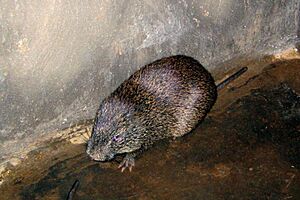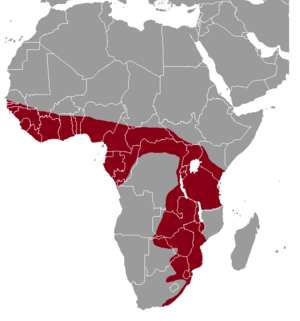Greater cane rat facts for kids
Quick facts for kids Greater cane rat |
|
|---|---|
 |
|
| Conservation status | |
| Scientific classification | |
| Genus: |
Thryonomys
|
| Species: |
swinderianus
|
 |
|
The greater cane rat (Thryonomys swinderianus) is a large rodent found in Africa. People in West Africa often call it the grasscutter. It is one of two types of cane rats, which are a small family of African rodents. These animals usually live near reed-beds and riverbanks in areas south of the Sahara Desert.
What Does a Greater Cane Rat Look Like?
Greater cane rats are quite big! Their bodies, from head to tail, can be about 43 to 60 centimeters (17 to 24 inches) long. Their tails add another 16 to 19.5 centimeters (6 to 7.7 inches).
Most greater cane rats weigh between 3.2 and 5.2 kilograms (7 to 11.5 pounds). Males are usually heavier, averaging about 4.5 kilograms (10 pounds). Females are a bit lighter, around 3.4 to 3.8 kilograms (7.5 to 8.4 pounds). Some very large cane rats can even weigh up to 9 kilograms (20 pounds)!
They are among the largest rodents in Africa. Only the porcupines of the Hystrix group are bigger. Greater cane rats have round ears, a short nose, and rough, bristly fur. Their front paws are smaller than their back paws, and each paw has three toes.
How Do Greater Cane Rats Behave?
Cane rats live in small groups. A single male usually leads each group. They are nocturnal, which means they are active at night. During the day, they rest in nests made from grasses or in burrows they dig underground.
These animals can live for more than four years. If a cane rat gets scared, it will make a grunting sound. Then, it will quickly run towards water to escape danger.
Greater Cane Rats and People
As people have built more homes and farms, they have moved into the areas where cane rats naturally live. Because of this, cane rats have also started to move from their natural reed habitats into farms. They especially like sugar cane farms, which is how they got their name.
Cane rats often eat crops like maize (corn), wheat, sugar-cane, and cassava. This makes them a problem for farmers, who see them as agricultural pests. However, people in the region also hunt cane rats for food. Their meat is considered a special treat. Because of this, some people have started raising cane rats in cages to sell them.



